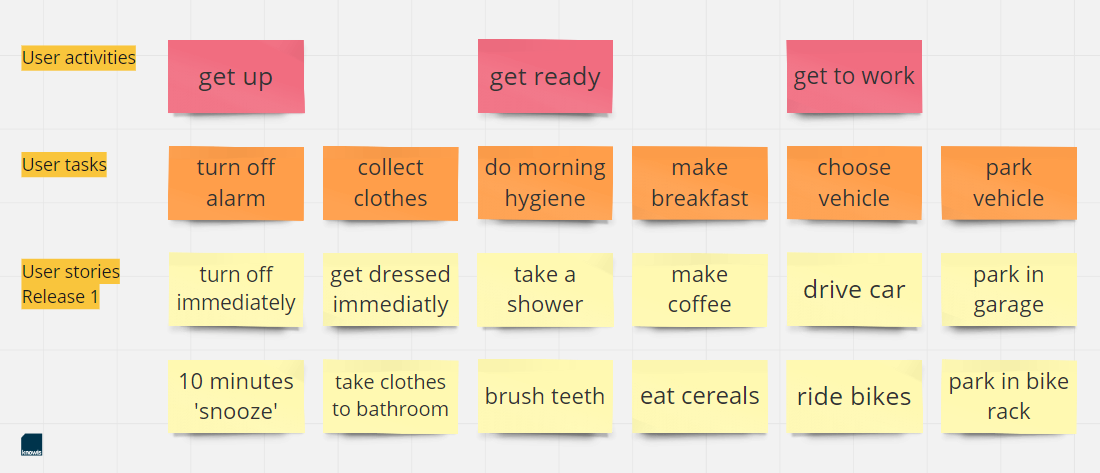
Well-thought-out and dedicated project management is crucial to the success of any large software project. Neglecting this task can lead to a massive cost explosion or even failure at an advanced stage. However, the use of agile project management methods can help the team to prevent such mishaps. One of these methods is User Story Mapping, which allows you to capture the big picture early and to consider the needs of different stakeholders. In this article, you will learn more about the basic principles of User Story Mapping, how it is used at knowis and why we see its greatest potential in combination with other professional methods.
Digitization projects have become commonplace in many industries. The intention is good, because those who do not want to get left behind on the market have to act fast. However, aimless action is counterproductive and companies often face difficulties during the implementation due to insufficient planning and rigid procedures. Almost everyone has heard of faltering or completely failed digitization projects. Whether Lidl, Haribo or the Federal Employment Agency – even well-known companies or large authorities with many years of experience have learned the hard way.
In project planning, it is often forgotten that technology and software are tools, which represent only one side of the coin. The real challenge of digital transformation is to correctly grasp, structure and optimize the sometimes very complex facts and procedures. However, this in-depth knowledge about internal processes must first be developed and then conveyed to the technology experts without any loss, in order to fully exploit the optimization potential.
A common problem in the planning process: you get bogged down in details and lose sight of the big picture. Agile project management and its associated principles, such as continuous communication with departments and short release cycles, can prevent this. User Story Mapping is a method that takes up this way of thinking.
The Basic Principles: The User, Many Stories and a Map
What is User Story Mapping? User Story Mapping is a visualization technique that is used particularly in the field of software development. It serves to acquire a common understanding of user needs and then, based on the user experience, to jointly create an overall picture of the processes and requirements to be implemented. What sounds a bit abstract at first, can be better understood after taking a closer look at the three main points of the method:
Focus: User
A product is as good as its users perceive it to be – that is the underlying principle. This applies in particular to software that is intended to map and facilitate work processes. The users want to experience added value through the software as quickly and directly as possible. Only with this prospect will they confidently accompany and support the implementation of the digital transformation from the very beginning. One pillar of the concept of User Story Mapping is therefore the consistent focus on the user experience. The clear definition of user personas, that is, fictional archetypes of a typical user of the software, provides orientation.
Stories, Stories, Stories
Following the focus on the user, a complete process sequence can be broken down to many individual narrative strands, each described from a specific user’s perspective – user stories. Ultimately, a user story is defined describing subtasks in an active-voice sentence, using everyday language and naming the goals of these individual steps.
This approach can be applied to complex business process sequences, resulting in a continuous workflow described from the perspective of the respective user. One of the goals of User Story Mapping is to break down and structure the process in such a way that, in the last step, you can formulate the detailed user stories and thus determine the exact requirements of the software.
Secure Navigation via Story Map
Even with supposedly simple process sequences, this results in a comprehensive overall picture with a large number of details and variants. The visualization through a story map, either with conventional Post-its on the wall or with online tools such as the RealtimeBoard, is a useful instrument for keeping track and navigating safely through the processes. This makes it much easier for the team to identify the points where tasks have been listed in too much detail and summarize them into higher-level groups.
The Course of a User Story Mapping Workshop
The participants of a User Story Mapping workshop, usually subject matter experts and developers, try to find out what is relevant to users and how to meet their needs quickly and accurately. Frequently, there is a wide range of views among the participants of what constitutes a convenient user experience. This has to do with the fact that everyone has a different background: IT experts prioritize different aspects than professionally-oriented practitioners. Developing a common understanding of the optimal user experience is therefore of immense importance when it comes to implementing all facets for the benefit of the user.
The starting point is the examination of the so-called user tasks, that is, the tasks that the user wants to complete with the help of the software. First, they are collected (for example, on sticky notes), sorted chronologically and arranged on the story map. For orientation, you should attach the profiles of the user personas so that they are clearly visible, in order to have them always in mind and to stay as close as possible to the user requirements. Tasks that are performed by similar roles at similar times to achieve a specific goal are summarized in activities. From the high-level activities and the associated tasks, the so-called backbone results, providing the structure of the story map.
After the participants have agreed on this framework and have thus established a fundamental, common understanding of the story map, the next step is to start the detailed work. The individual tasks are divided into sub-tasks; alternative tasks or exceptions are incorporated into the map. Based on this detailed structure, the individual stories are then formulated in the course of the project and translated into software step by step.
User Story Mapping Based on a Person's Daily Routine
An instructive comparison from the book User Story Mapping by Jeff Patton illustrates the approach based on the daily routine of a person. Going through your tasks one by one, you sort them in chronological order. You will come up with tasks such as 'get up' , 'brush teeth', 'take a shower', 'get dressed', 'make breakfast' and so on. By considering all sorts of perspectives, variations become apparent: some people do not have breakfast at home, some go to work by bike, others by car. Due to certain events, for example illness, the entire process may change. New tasks are added ('inform employer'), others are completely eliminated ('get to work').
This first set of tasks is then structured more precisely using the story map, grouping some tasks into activities and classifying others as sub-tasks or further subdividing them. 'Get ready' can be used as an activity for the tasks 'do morning hygiene' and 'make breakfast', while 'make breakfast' can be further subdivided into the sub-tasks 'make coffee' and 'eat cereals'. This refined structure is then the basis for the formulation of the stories, which describe the actions that are necessary to fulfill the task. In the example of 'make coffee', the story could be: As a person having breakfast, I make coffee to wake up.
Practical Experience - User Story Mapping at knowis AG
At knowis AG, we have learned that the methodology of User Story Mapping helps us to handle a high level of complexity, which regularly occurs in the implementation of banking platform solutions. The requirement is often to develop networked solutions for different user groups in parallel, which, in turn, requires implementation by several development teams. For this reason, the overview for all project teams must be guaranteed at all times for successful control and orchestration of the platform development.
In many projects, we use also agile methods (Scrum) for the software development, in which clearly defined process steps are translated into functional software elements. User Story Mapping serves as a helpful method to keep track. Planning the individual development steps can be carried out in a structured way in practice using the Story Map, because it allows you to grasp at a glance the functional requirements including prioritization and contexts.
With the help of user personas, such as account managers, decision makers or collateral managers, we can develop and take into account even the needs of those users who are not represented by the workshop participants. This means there is no need for the complete implementation team to be present to collect the requirements. The requirements can be raised – through the lens of fictional users – by analysts and a team of experts who have no direct relation to the respective process.
Some practical advice: In order to avoid frustration among those involved, it is advisable, first of all, to become clear about the goal of each User Story Mapping workshop. The circle of participants should always be selected with this objective in mind. While defining the desired process, other people may be required than during the surveying and visualization of existing processes. When it comes to changing significant processes, very often specifications or restrictions are to be observed that the user does not know. Consequently, there is a danger that an apparently perfect process will be designed, that in reality cannot be implemented, which leads to frustration among the participants. Therefore, it is recommended to involve the head of the department, for example, or other decision-making personnel.
Conclusion
With the help of User Story Mapping, the customer's expectations can be implemented in a targeted and inter-divisional manner. Compared to other agile project management methods, it is characterized by a consistent focus on the user experience and the expectations of the respective stakeholders. The perspective is always future-oriented, you look ahead and do not spend much time on well-known problems. It is easy for the workshop participants to learn, understand and implement this method.
However, there are other approaches, such as Event Storming or Design Thinking, which are increasingly coming into focus for project managers. Quo vadis, User Story Mapping? From our point of view, the method is an important element in the project management of digitization projects. The reason for this is primarily the easy derivation of requirements for the product backlog. The realistic planning of the scope and resources is significantly supported by User Story Mapping. Project disasters as described earlier become notably less likely with the use of this method.
Nevertheless, User Story Mapping is not a panacea for solving all problems in project work. We see the greatest potential in combination with other methods that specialize in different phases of the project or emphasize a different perspective. Event Storming, for example, is chronologically one step ahead of User Story Mapping: Its first step is to identify processes that offer room for improvement, while Story Mapping already has an idea for optimization. Also, the focus is different: it is not the user who is placed in the foreground, but rather existing problems. Only through the skillful combination of different agile methods, in our experience, are all aspects of the project business optimally supported.
Image Sources: Teaser: Dragan Radojevic - 508188164 - iStock; Infographic: knowis AG










